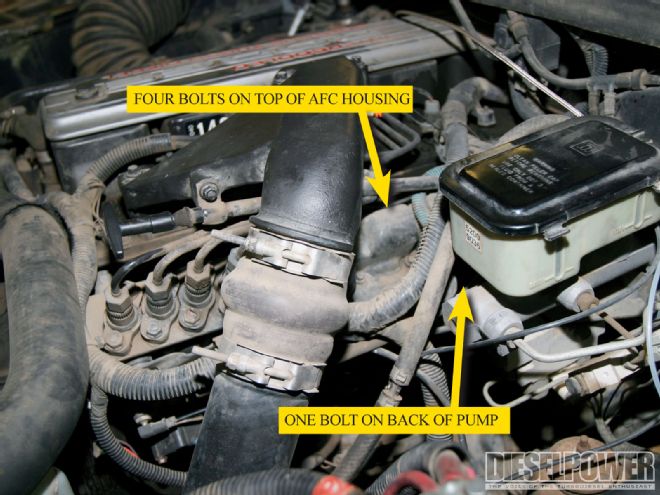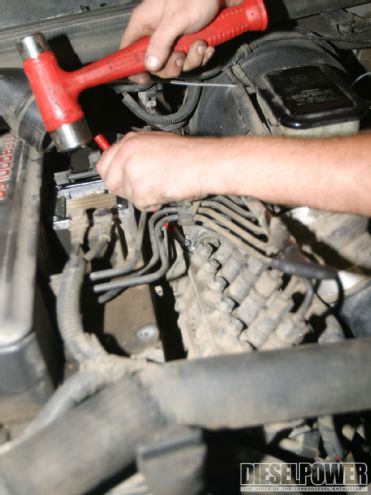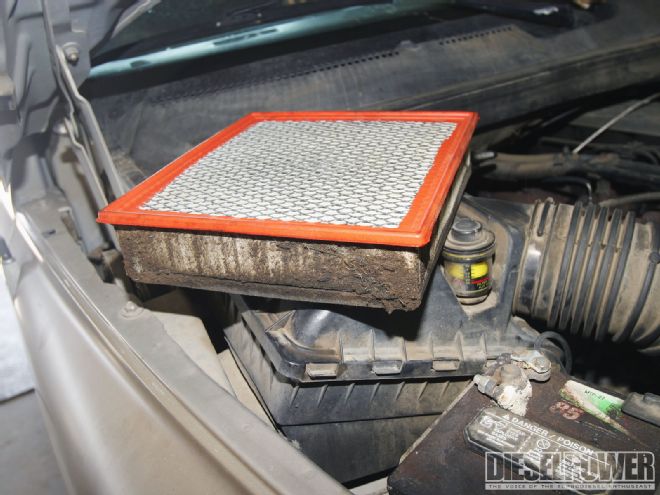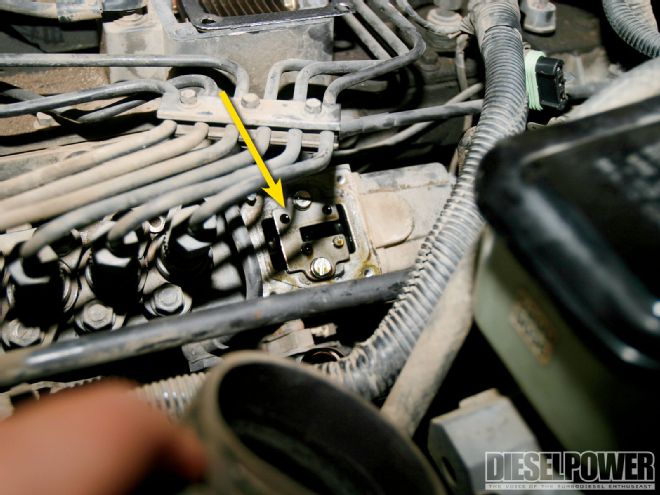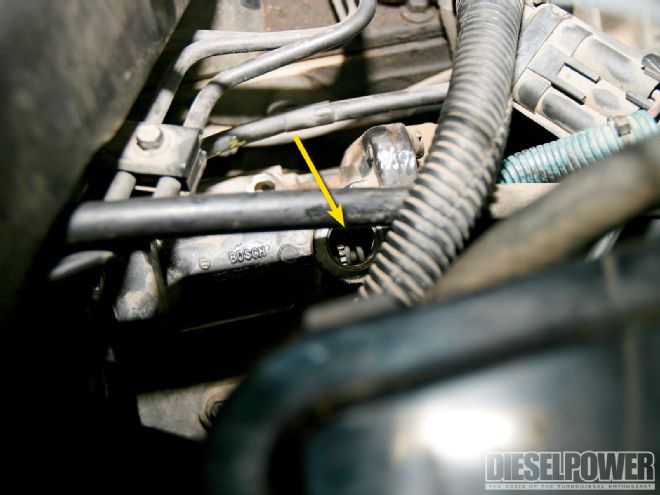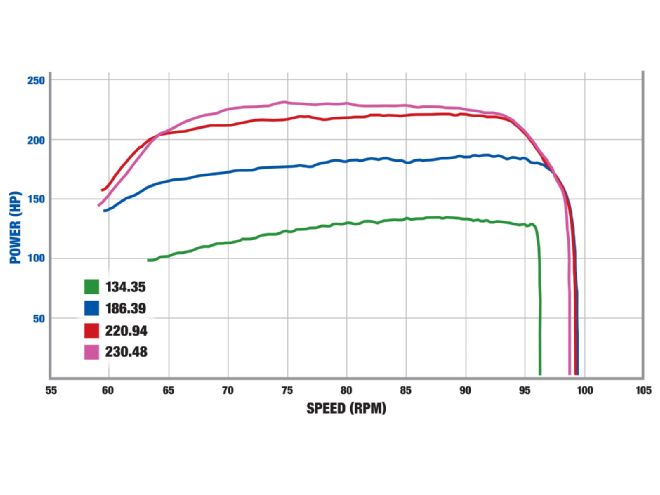In our "Project Triple Threat" editorial (Dec. '10), we introduced you to our '95 Dodge that has been tasked with the ubiquitous duty of being a daily driver, sled puller, and dragstrip machine. Every journey has to have a first step, and before we get on with making our Dodge a mega-horsepower monstrosity, we've decided to see what we can do with a bone-stock truck and absolutely no dough. Besides, one can only drive around a 3-ton, 160hp truck for so long before they pull their hair out and go crazy.

| After all the free modifications, our 160hp-rated 5.9L Cummins put down 230 hp and 625 lb-ft at the rear wheels-with just a light haze of smoke.
Stock
In this case, stock means stock. As in, 277,147-mile, used-truck, stock. For those of you who are looking for impressive dyno numbers in factory form, check elsewhere. The truck was rated at 160 hp from Dodge, and with about a 20 percent loss due to drivetrain friction, we were left with 134 hp and 315 lb-ft of torque at the rear wheels. The EGT was an utterly safe 950 degrees, and boost was a turbo-saving 19 psi.
Step 1: Fueling Tricks
Our first round of free modifications consisted of sliding the fuel plate all the way forward toward the radiator, moving the AFC (air-fuel-control) housing all the way forward, and turning the starwheel toward the passenger side of the truck to bring fuel on quicker. With these modifications, power jumped up by more than 50 hp (up to 186 hp), while torque came in at 477 lb-ft. The exhaust gas temperature was 1,200 degrees by the end of the dyno run, indicating we were fueling a lot harder than stock. Boost pressures still stayed at 19 psi, which made us think that's what the wastegate was set at. At this level of modification, there was barely any smoke.

| With the engine running, a hole was drilled in the exhaust manifold for a pyrometer. The engine was turned off to insert the probe, but having the engine idling during drilling is thought by some to be a good way of blowing the metal shavings out of the manifold, rather than sending metal bits through the turbocharger.
Step 2: Removing The Fuel Plate
Dodge guys say taking the fuel plate out of the injection pump gives the pump more rack travel and increases power. And boy, did it. The horsepower shot up another 34 points, peaking at 220 hp. The new torque output was bumped to 586 lb-ft. Boost was also up slightly to 24 psi, which made us believe we were starting to overcome the factory wastegate setup. The EGT was still climbing, and we observed 1,300 degrees at the end of our dyno run. The truck put out a pretty good haze of black smoke at this power level.
Step 3: Wastegate Clamped Shut
To get the most turbo boost possible, we clamped the blue hose leading to the wastegate shut. Keep in mind, the wastegate's job is to protect the turbo from spinning too fast. By pinching the line shut, the turbo may overspeed and break apart. On a positive note, this modification increased the boost to 35 psi, reduced the EGT to 1,250 degrees, and netted 230 hp and 625 lb-ft of torque. We even tried running the engine with no air filter, but 230 hp was all this Cummins had in it. Oh well, 96 hp and 310 lb-ft isn't too bad of a gain, considering we didn't spend a single penny on modifications.

| We clamped the wastegate hose shut with vise grips and saw 35 psi of boost on the gauge. However, since our power went up only slightly, we'd probably skip this step for the sake of turbo reliability.
Conclusions
With our newfound power, the truck now blows through the torque converter (it slips) until we hit lockup in Overdrive-then the Dodge pulls pretty hard. Driveability is also much better, as the truck feels very snappy compared to how it felt before. We can break the tires loose in First gear, and the exhaust smoke at this point is still very light. We debated putting a manual lockup switch in the truck (to lock the converter in lower gears) but decided we'd take it easy on our stock transmission. We're very pleased with how the free mods turned out, and we wouldn't hesitate to recommend someone perform these steps in their driveway. If you're going to be doing any foot-to-the-floor towing, we'd install an EGT gauge, but if you just hot-rod around town, gauges probably aren't even needed on '94 and '95 trucks. Dodge models from '96 to '98 (rated at 180 hp and 215 hp) will gain even more power with the same modifications and will almost surely need gauges to make sure EGT doesn't get too toasty.
Budget: Not Included
There are certain things wrong with our '95 Ram that we're not going to include in our budget. To us, it's just the price we pay for buying an older vehicle. These issues include:

| We mocked up a temporary boost gauge in addition to the pyrometer. We'll be doing a full gauge install story soon, in which we'll permanently mount boost, EGT, and maybe even transmission temperature gauges on our Dodge.
- Truck pulls to the left, especially during braking
- Windshield is cracked
- Passenger-side window switch doesn't work
- Automatic door locks don't work
- Tires are worn out
- Sloppy steering issues
- World's most corroded battery terminals
- Bad fuel sending unit in fuel tank
While none of these issues (when fixed) will add horsepower, most will still need to be addressed and will probably cost us in parts and labor.
KEEPING A BUDGET
'95 Dodge Ram 2500
$5,500
Injection pump and turbo modifications
FREE
Labor cost to perform mods
$100
Total Parts
$5,500
Total Labor
$100
Project Total to Date
$5,600
Performance to Date:
17.52 seconds at 73.5 mph, 230 rwhp and 625 rwtq
Slow Quarter-Mile Times
While our truck was painfully slow in stock form, running 19.9 seconds at 65 mph in the quarter-mile, our 17.52-second elapsed time (at 73.5 mph) after our free modifications didn't show its true potential. With our stock torque converter and no governor springs, the truck would hang every shift (run up to the point when the engine defuels and stay there for a second or two), and the torque converter never locked unless we pedaled the throttle in Overdrive. Soon we'll be adding injectors and performing more injection pump modifications, which means we'll need to upgrade the transmission. Then, hopefully we can actually run halfway decent elapsed times.
